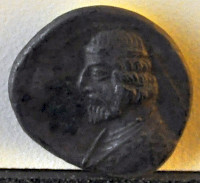Arsaces XIII, Gotarzes I
Arsaces XIII, Gotarzes I: Arsacid king during a brief "dark period" in the history of the Parthian Empire (r.91-87).

The rule of the Parthian king Mithradates II had been very successful: he had secured the northeastern border, had invaded Armenia, had conquered all land east of the Euphrates, had concluded a friendship treaty with the Roman Republic, and had stimulated the economy. Few rulers had achieved so much. Yet, towards the end of his reign, there were domestic problems, which are poorly understood. Scholars call this the "dark period" in Parthian history, which lasted about three decades..
In 93/92, his relative Sinatruces had revolted in Elam (93/92) and proclaimed himself king when he learned of Mithradates' death in 91. Mithradates' son Gotarzes I had to suppress this insurrection. Because Gotarzes' oldest coins were minted in the northern area, it seems that this was his power base, from where he gradually pushed back his rival. (The fact that he was married to Aryazate, daughter of king Tigranes II of Armenia, is other evidence for this "northern connection".) Several months after his final victory in 88/87, Gotarzes' own reign came to an end. He was succeeded by Mithradates III.
Perhaps Rock Relief V in Sar-e Pol-e Zahab, along the road from Babylonia to Media, was made for Gotarzes I, although Gotarzes II is a better candidate.
Note
The chronology of the Arsacid kings of the Parthian Empire is less well-understood than, for example, the sequence of Seleucid and Ptolemaic kings or the emperors of Rome. This information is based on the researches by G.R.F. Assar, as published in "Iran under the Arsakids, 247 BC – AD 224/227" in: Numismatic Art of Persia (2011).